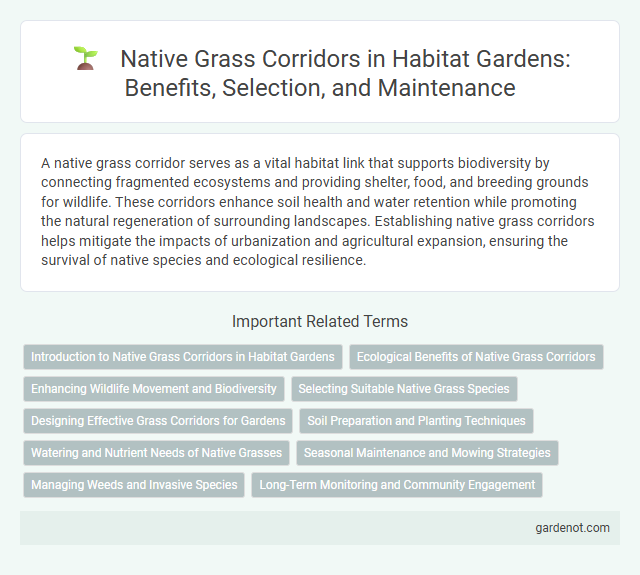A native grass corridor serves as a vital habitat link that supports biodiversity by connecting fragmented ecosystems and providing shelter, food, and breeding grounds for wildlife. These corridors enhance soil health and water retention while promoting the natural regeneration of surrounding landscapes. Establishing native grass corridors helps mitigate the impacts of urbanization and agricultural expansion, ensuring the survival of native species and ecological resilience.
Introduction to Native Grass Corridors in Habitat Gardens
Native grass corridors in habitat gardens create essential pathways that support biodiversity by connecting fragmented ecosystems. These corridors provide shelter and food sources for pollinators, birds, and small mammals while promoting soil health through deep-rooted grasses like big bluestem and switchgrass. Establishing native grass corridors enhances ecosystem resilience and facilitates natural species movement within urban and rural landscapes.
Ecological Benefits of Native Grass Corridors
Native grass corridors enhance biodiversity by providing essential habitats and food sources for pollinators, birds, and small mammals. These corridors improve soil health through deep root systems that prevent erosion and increase nutrient retention. They also contribute to carbon sequestration, helping to mitigate climate change effects in surrounding ecosystems.
Enhancing Wildlife Movement and Biodiversity
Native grass corridors play a crucial role in enhancing wildlife movement by providing continuous natural habitats that facilitate safe passage for species between fragmented ecosystems. These corridors support biodiversity by offering essential food sources, shelter, and breeding grounds for various native fauna and flora, promoting genetic exchange and ecosystem resilience. Implementing native grass corridors contributes to habitat connectivity, reducing the impact of habitat fragmentation and supporting conservation efforts for threatened wildlife populations.
Selecting Suitable Native Grass Species
Selecting suitable native grass species for habitat corridors enhances biodiversity and ecosystem stability by providing essential food and shelter for local wildlife. Species such as Big Bluestem (Andropogon gerardii), Little Bluestem (Schizachyrium scoparium), and Switchgrass (Panicum virgatum) are well-adapted to regional climates and soil conditions, promoting native pollinators and soil health. Incorporating diverse native grasses ensures resilience against invasive species and supports long-term ecological connectivity within the corridor.
Designing Effective Grass Corridors for Gardens
Designing effective native grass corridors for gardens involves selecting region-specific grass species that support local biodiversity and enhance pollinator habitats. Incorporating a mix of tall and short native grasses ensures structural diversity, which provides shelter and food for various wildlife. Proper spacing and soil preparation improve water retention and root establishment, optimizing corridor resilience and ecological function.
Soil Preparation and Planting Techniques
Effective soil preparation for native grass corridors involves deep tilling to improve aeration and moisture retention, combined with the removal of invasive species to reduce competition. Planting techniques prioritize the use of locally sourced seed mixes that promote biodiversity and ecological resilience, with direct seeding methods timed to coincide with optimal seasonal conditions. Incorporating mycorrhizal fungi during planting enhances root establishment and nutrient uptake, ensuring a healthy and sustainable native grass corridor.
Watering and Nutrient Needs of Native Grasses
Native grass corridors require consistent watering to maintain soil moisture levels crucial for root development, typically needing about 1 to 1.5 inches of water per week depending on climate conditions. These grasses thrive in nutrient-poor soils but benefit from periodic applications of slow-release nitrogen fertilizers to enhance growth without causing nutrient runoff. Proper watering schedules combined with minimal nutrient supplementation support the resilience and ecological function of native grass corridors, promoting biodiversity and soil stability.
Seasonal Maintenance and Mowing Strategies
Native grass corridors require seasonal maintenance to preserve biodiversity and facilitate wildlife movement. Mowing strategies should prioritize timing, avoiding peak growing seasons to allow seed dispersal and habitat regeneration. Implementing a rotational mowing schedule every 2-3 years minimizes soil disturbance and supports native plant resilience.
Managing Weeds and Invasive Species
Managing weeds and invasive species in native grass corridors is essential for preserving biodiversity and promoting ecosystem health. Effective strategies include targeted herbicide application, manual removal, and the use of native plant mulches to suppress invasive growth. Monitoring and early detection of invasive species such as Johnson grass and Canada thistle help maintain the corridor's ecological integrity.
Long-Term Monitoring and Community Engagement
Long-term monitoring of native grass corridors involves systematic data collection on species diversity, soil health, and habitat connectivity to assess restoration success over time. Community engagement plays a crucial role by fostering local stewardship through educational workshops, citizen science programs, and volunteer planting events that support corridor maintenance. These combined efforts enhance ecological resilience, promote biodiversity, and ensure sustained habitat functionality across fragmented landscapes.
Native grass corridor Infographic

 gardenot.com
gardenot.com